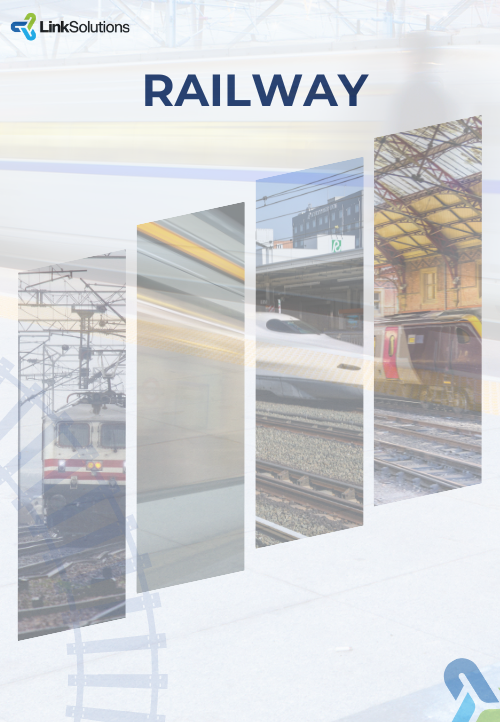
RAILWAY
At Link Solutions, we specialize in providing our customers with a comprehensive labeling system tailored to their industry, including the mass transit sector. The railway industry, encompassing both rolling stock and mass transit, is a complex and crucial sector in today’s modern transportation when it comes to efficiency, safety, and order in rail transport. Labeling in this industry refers to the precise and important identification of various components, signals, carriages, and the infrastructure along the railway network. This allows for systematic identification of electrical cables and wires, serving multiple purposes for safe operation.
Safety is a top priority in the railway industry, including mass transit, and accurate and clear labeling of cables directly contributes to this goal. Labeling helps technicians, engineers, and other personnel identify and diagnose cables, reducing errors and accidents in everyday operations within both rolling stock and mass transit environments.
Accurate information and safety are essential in this sector, where many people, utilizing both rolling stock and mass transit, travel at high speeds every day. Precise information about infrastructure and signals is crucial to avoid collisions and accidents.
Efficient day-to-day operations are also influenced by labeling, as the identification of trains, carriages, cargo, and destinations makes it easier to manage and prevent delays. Similarly, labeling assists in keeping track of infrastructure maintenance by specifying areas in the sector that require repair or attention.
Therefore, labeling is a crucial component for maintaining efficiency and safety in the railway industry and minimizing risks, ensuring a secure and well-organized sector for all involved parties. Reliability is a key to successful train operations, and correct labeling is a crucial factor in maintaining this reliability.
Why labeling is important in the railway industry:
- Safety Assurance: Clear labeling identifies potential safety risks and prevents accidents.
- Efficient Operations: Labeling enables quick identification, reduces delays, and ensures efficient train transport.
- Maintenance Management: Facilitates targeted maintenance planning, reducing downtime.
- Error Reduction: Increases reliability through precise identification and diagnosis of issues.
- Compliance with Standards: Ensures materials meet fire safety standards, enhancing user experience.
Why Link Solutions?
Link Solutions labeling contributes to ensuring that all key stakeholders in the sector can be connected, and safety is paramount. The significance of public transportation in daily life, whether by train, metro, or tram, is becoming increasingly important worldwide due to the growth of cities. Alongside this, there are also more requirements and specifications for materials that must contribute to ensuring optimal safety. There is a constant emphasis on factors such as fire safety, given the increasing number of passengers using the industry as their preferred mode of transportation.
Link Solutions stands out as one of the few in the market that meets the specifications required to achieve the best safety in labeling for various areas within the industry.
- Europa: Important standards in railway labeling in Europe ensure the safety and quality of products, encompassing both rolling stock and mass transit applications. For instance, EN45545-2 (hazard level), HL3 (requirement set), R22 and R23 classifies materials based on fire behavior, smoke, and toxicity. Compliance with such standards is crucial to meet safety requirements and maintain a high level of security in the diverse aspects of the railway industry, covering both rolling stock and mass transit contexts.
- North America: In North America, crucial standards for railway labeling, spanning both mass transit and rolling stock, are established by organizations like NFPA130 and ASTM. ASTM standards, such as ASTM E 162, ASTM E 662 and ASTM E 1354 for flammability resistance, help ensure that labeling materials meet specific safety criteria. This includes Boeing BSS 7239 as well. These standards are essential for maintaining safety and quality in the labeling practices within the diverse North American railway industry, covering various applications in both mass transit and rolling stock contexts.
- UK: The London Underground 1-085 A3 standard addresses fire safety in materials, including labeling, for mass transit rolling stock applications. These standard outlines specific requirements to ensure that materials used in rolling stock, within the context of mass transit like the London Underground, meet stringent fire safety standards. Adherence to the 1-085 A3 standard is crucial for maintaining a safe and secure environment for both passengers and personnel in the London Underground’s mass transit.
All these standards are crucial for ensuring the safety and quality of Link Solutions labeling in various sectors. As public transportation becomes increasingly important globally, these standards help guarantee that our labeling meets the necessary criteria for fire resistance, toxicity levels, and other essential factors, ensuring the highest standards of safety and reliability in the industry.
The HL levels are defined as follows:
à **HL 1**: Applies to vehicles that operate on open tracks with easy access and low speed. Examples are freight trains, shunting locomotives and maintenance vehicles.
à**HL 2**: Applies to vehicles that operate on open tracks with easy access and high speed, or on closed tracks with easy access and low speed. Examples are regional trains, trams and metros.
à**HL 3**: Applies to vehicles that operate on closed tracks with difficult access and high speed, or on open tracks with difficult access and low speed. Examples are high-speed trains, underground trains and trains that operate in long tunnels.
The higher the hazard level, the more stringent the requirements for fire behavior of materials and components. The requirements are specified in terms of flammability, smoke emission and toxicity for internal and external applications.
With this, you can be assured that our products deliver the materials needed to create the best safety in the railway industry.


